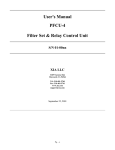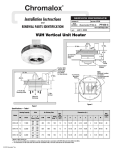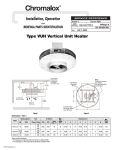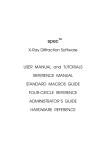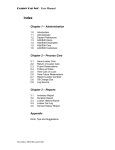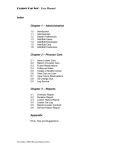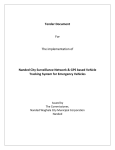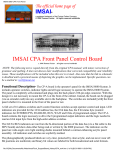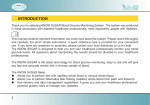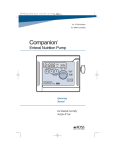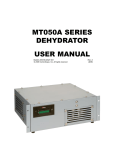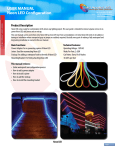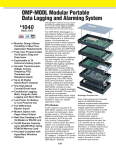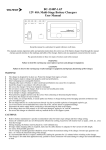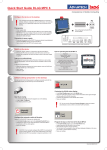Download User`s Manual PFCU-4 Filter Set & Relay Control Unit
Transcript
Model PFCU S/N 9x-00nn User's Manual PFCU-4 Filter Set & Relay Control Unit S/N 9x-00nn X-ray Instrumentation Associates 1300 Mills Street Menlo Park, CA 94025-3210 (415)-325-5779 February 15, 1991 1 Model PFCU S/N 9x-00nn Contents: I: Warranty and Registration Card ........................................................... 3 A: Our guarantee policy ....................................................................... B: Our repair service............................................................................ C: Warranty Card ................................................................................ II: General Product Description................................................................. A: Features ................................................................................... B: Description C: Specifications................................................................................ D: Applications................................................................................... III: Installation A: Unpacking ................................................................................... B: Mechanical Installation ................................................................... C: Electrical Connections ................................................................... D: Initial Testing ................................................................................. IV Operation A: Normal Operation ........................................................................... B: Open Circuits ................................................................................. C: Short Circuits ................................................................................ V Troubleshooting and Service ................................................................ A: Detailed Theory of Operation ........................................................... B: Service ................................................................................... VI: Assembly Drawings and Parts List....................................................... A: Assembly Drawings ........................................................................ B: Parts List ................................................................................... 2 Model PFCU S/N 9x-00nn Section I: Warranty and Registration Card I.A. Our Guarantee Policy PFCU control units are guaranteed against failure under normal operating conditions for 1 year from time of purchase. Should a unit fail, it will be repaired or replaced in as expeditious a manner as possible to minimize disruption to its owner's experiments. In such an event please call us immediately to arrange for free repair service. Be sure to register your instrument. I.B. Our Repair Service In line with XIA's goal of making your experimental life easier, we also have a repair service which will attempt to repair, at a reasonable cost, any XIA instrument that fails, whether it is in warranty or not. The components of this service, which can be selected as your needs require, include: 1: Timely repairs: Our goal is to complete normal repairs in 2 working days or less. 2: Complete testing and checkout before return to assure that the repaired instrument will continue to perform reliably. 3: Loaners: to keep your experiment running if we expect a delay in obtaining necessary replacement parts. 4: Expedited handling: by 2nd day, overnight or even same day rush delivery to get you going again in critical situations. I.C. Warranty Card In order to register your instrument for our guarantee policy, please fill out and return the warranty card at the bottom of the Warranty Information sheet. 3 Model PFCU S/N 9x-00nn Section II: General Product Description I.A. Features ❖ Implements both manual and computer control of PF4 filter unit, small relays or other experimental equipment ❖ 4 output lines, each at 24V, 5 - 100 mA, diode protected for inductive loads. ❖ Outputs switched by front panel switches or TTL remote control input signals ❖ Detects both open and short circuits as error states; short circuit protected. ❖ Panel LEDs show normal activation, flash for errors states. ❖ Reports normal output activation status with TTL output signals ❖ Single width NIM module powered from the NIM bin I.B. Description The Model PFCU-4 is a flexible control unit both for such XIA products as the Model PF4 Filter Inserters and Model PF2S2 Filter/Shutter Units and for many other types of small experimental equipment. Packaged as a single width NIM module, it implements both manual control, via front panel switches, and remote control, via TTL logic inputs and outputs. It is thereby compatible with a variety of computer I/O modules, including both CAMAC modules and personal computer I/O cards. Since its 4 output lines are rated for inductive loads of up to 100 mA at 24 Volts, it may also be used to control a variety of other experimental equipment as well, either directly or through the use of relays. The Model PFCU-4 has the following control logic for each of its 4 output lines: the output is switched by two ORed inputs (a front panel switch and a remote, Active Lo, input logic level). The resulting output line condition is shown by a panel LED and output as an Active Lo TTL logic level. In this manner, if remote control is overridden from the front panel, the actual experimental situation is still reported and can be accurately stored in the remote controller's data record. Currents of less than 3.5 mA or greater than 110 mA are detected and interpreted as "open" and "short" circuit conditions, respectively. As a protective feature, the output is switched off in approximately 1 µs following detection of the short condition and must be reset before normal operation can resume. Both short and open conditions are indicated by flashing the faulty circuit's front panel LED and switching its output line High. Both the TTL input and output lines are configured active Lo (0 volts = logic 1) I.C. Technical Specifications Physical SIZE: Single width NIM module. Power Required (from NIM Bin) +12 V: 200 mA. +24 V: up to 400 mA, depending on load. Inputs FRONT PANEL: 4 SPST switches "In/Out". REMOTE INPUT: DB9 M plug, Active Lo TTL levels: 0 Volts = "1" = "In". 4 Model PFCU S/N 9x-00nn Controlled Output 24V, 5 - 100 mA; diode protected for inductive loads. Connector: DB9 female receptacle. Status Output DB9 F receptacle; Active Lo TTL levels: 0 Volts = "1" = "valve actuated". Fault Detection Open Circuit: Output currents below 3.5 mA are indicated as open circuits by flashing the circuit's front panel indicator LED and switching its status output line to "0". Short Circuit: Output currents above 110 mA are switched off and the condition indicated by flashing the circuit's front panel LED and switching its status output line to "0". The circuit must be reset (both inputs turned off) before it will operate normally again. I.D. Applications The PFCU-4 is principally intended for controlling XIA's PF4 and PF2S2 filter and filtershutter sets. When purchased with an appropriate connector cable (see below) nothing further is required to implement manual control. To implement computer control, only user-specific computer-to-PFCU connection cables are required. Using this PFCU/PF4 package, it is simple to automate data collection routines for samples whose x-ray scattering exceeds the dynamic range of the detector by having the system control computer use the PF4 to adjust the intensity of the x-ray beam via the PFCU interface. With its convenient control system and protected outputs, the PFCU is also well suited for more general experimental control. It is equally capable of driving solenoids, lamps, small heaters, relays and various electrically operated valves. Equipment whose power requirements exceed the PFCU's rating may still be controlled through the use of intermediate relays. I.E. Related Products XIA also sells connector cables, designated PF-CAB-xx which are specifically intended to connect the PFCU to either a PF4 or a PF2S2 unit. Available lengths xx are 15', 25' & 50'. These are 9 conductor, 26 AWG cables configured as 4 twisted pairs plus ground inside a foil sheath. This arrangement provides exceptional signal immunity to noise in large facility or industrial environments. 5 Model PFCU S/N 9x-00nn Section III. Installation III.A. Unpacking When unpacking your PFCU, you should find the following 3 items: ❏ The PFCU control module. ❏ This instruction manual. ❏ A Warranty Card. Please fill out and return the warranty card before you forget. The following installation instructions are written assuming that the PFCU will be used to control a PF4 filter set. For other applications, appropriate changes should be made in the indicated procedures. III.B. Mechanical Installation The only mechanical installation required is to insert the PFCU into a NIM bin and tighten the front panel thumbscrews. III.C. Electrical Connections III.C.1. Back Panel: Connections to Controlled Equipment Connections between the PFCU and the controlled equipment (e.g. PF4) must be made as shown in the following sketch, Figure 1.. Please note that the Returns are switched and must be kept as separate leads. The common +24 Volts may be run as a single lead if desired. 6 Model PFCU S/N 9x-00nn Figure 1. Connections from PFCU to controlled equipment PFCU Back Panel 9 Pin Female D Connector 5 4 9 3 8 2 7 1 6 Pinning Chart Output 1 2 3 4 Common +24 V 6 7 8 9 Switched Return 1 2 4 5 PF4 9 Pin Male D Connector 1 2 6 3 7 4 8 5 Pinning Chart Valve 1 2 3 4 V+ 6 7 8 9 V- 1 2 4 5 9 Cables designated PF-CAB-xx obtained from XIA make these connections with the leads for each output as a twisted pair and lead #3 as a connecting ground, as shown in the following sketch, Figure 2.. Any cable with DB9 Male and Female connectors and straight through connections may be used instead if it is rated to produce less than 1 Volt drop for the intended current over twice the desired cable length. 7 Model PFCU S/N 9x-00nn Figure 2. DB9 - Male Pin # DB9 - Female Pin # Cable 1 6 2 7 4 8 5 9 3 Connector Shell, if any Connector Shell, if any Foil Shield, if any Foil Shield, if any Wire Size 1 6 2 7 4 8 5 9 3 26 or 28 Gauge, nominal 0.065 ohm/ft maximum. III.C.2. Front Panel: Connections to Computer Equipment The required connections to appropriate computer controlled input and output registers should be made as shown in the following sketch, Figure 3. Both inputs and outputs are Low Power Schottky TTL and are therefore compatible with both TTL and HCMOS circuitry (Vin < 0.5 V for Low, Vin > 2.7 V for High). Both input and output are Active Low, so that nominal 0 Volts is a logic 1, and grounding an input pin (e.g. 3) will activate the associated PFCU output channel (#2), causing the equivalent output pin (#3) also to go Low. The active low convention was adopted to ease interfacing the PFCU to CAMAC control systems where it is common to many input/output devices such as the Joerger QIR and QOR. 8 Model PFCU S/N 9x-00nn Figure 3. PFCU Front Panel Connectors "Status Output" (9 Pin Female D Jack) 1 2 3 4 5 Pinning Chart 6 7 All TTL signals Active Low: 0 Volt = Logic 1 8 9 Pin "Control Input" (9 Pin Male D Plug) 5 4 3 2 1 Signal/Channel 1 Ground 2 1 3 2 4 3 5 4 9 8 7 6 III.D. Initial Testing ❏ ❏ ❏ ❏ ❏ ❏ III.D.1: PFCU initial manual testing Install PFCU in NIM Bin Power up NIM Bin Throw each front panel switch on PFCU in turn and observe the following: 1: Associated LED on PFCU panel lights up in flashing mode. Attach Male end of interconnector cable to rear of PFCU, F end to PF4 Throw each front panel switch on PFCU in turn and observe that the following different things occur: 1: Associated LED on PFCU panel lights up but does not flash. 2: Corresponding PF4 valves LED lights up. This completes initial manual testing unless you want to throw the switches a few more times. III.D.2: PFCU initial computer control testing ❏ Have a computer controlled TTL output register of at least 4 bits and a program to change their values. 9 Model PFCU S/N 9x-00nn ❏ Have a computer controlled TTL input register of at least 4 bits and a program to read their values. ❏ With NIM bin and Computer arrays powered off: 1: Connect the PFCU "Control Input" lines to the TTL output bits. 2: Connect the PFCU "Status Output" lines to the TTL input bits. ❏ Turn the NIM bin and Computer arrays power back on. ❏ With all manual switches in OFF position, use the computer to toggle each TTL output bit from 1 to 0 (High to Low) in turn and observe that the following things all happen: 1: Appropriate PFCU front panel LED comes on. 2: Associated PF4 valve LED comes on. 3: Associated Status bit toggles from 1 to 0 (High to Low). ❏ Also observe that when the output bits are toggled from 0 to 1 (Low to High) the opposite things all happen: 1: Appropriate PFCU front panel LED goes off. 2: Associated PF4 valve LED goes off. 3: Associated Status bit toggles from 1 to 0. ❏ Now, with all computer output bits set to 1 (High), use the front panel switches to turn each valve on and off in turn and confirm that the same behavior occurs as under computer control. Namely: 1: Appropriate PFCU front panel LED turns on and off. 2: Associated PF4 valve LED turns on and off. 3: Associated Status bit toggles from 1 to 0 and back. ❏ This completes initial computer control testing. III.A.3: Testing PF4 Pneumatic Operation ❏ This test can be performed either jointly with the tests of III.A.1 and 2 or separately. ❏ In addition to the setup required above, the PF4 must also be attached to a source of high pressure Air or Inert Gas as per the PF4 instruction manual. ❏ The test procedures are then identical to those of Sections III.A.1 and III.A.2 above except that an additional visual inspection is needed to confirm that, when each PF4 valve LED is lighted its corresponding pneumatic cylinder is also activated, dropping its foil carrier (or their shafts, if the foil carriers have not yet been mounted) into the beam path. 10 Model PFCU S/N 9x-00nn Section IV: Operation IV.A. Normal Operation The normal operation of the PFCU is quite straightforward. It consists of 4 identical circuits, cleverly numbered 1 through 4. Each circuit is controlled by 2 inputs: a front panel switch and a TTL control input line. Each circuit also has two output lines: a switched power return line and a TTL status output. The correspondences between circuits and input and output lines is shown in Figures 1 and 3. The circuit's two inputs are logically ORed together so that when either the switch is in the "In" position or the TTL input is LO the circuit is activated. When the circuit is activated its power return line is connected to ground through a switching transistor and its TTL status line is switched LO. Any external device connected between the power return line and the +24 Volts supplied is thereby also activated. IV.B. Open Circuits The current passing through the switching transistor is sensed and compared to 3.5 mA. A value less than 3.5 mA when the circuit is supposed to be activated is interpreted as an "Open" circuit and causes the circuit's front panel LED to flash as well as the output status line to be set HIGH. As soon as the open circuit condition is removed the circuit returns to normal operation. IV.C. Short Circuits The current passing through the switching transistor is also compared to a value of 110 mA. A current of greater than 110 mA is interpreted as a "Short" circuit and causes an internal flip-flop to be set to its "Short circuit detected" position. This causes the switching transistor to be shut off, the front panel LED to flash, and the output status line to be set HIGH.. The entire detection and shutoff time is less than a microsecond. When the short circuit condition has been corrected, the circuit must be reset, by switching both of its inputs OFF, before it can be turned on again to resume normal operation. Notice that only a short circuit in the controlled circuit is detected. Shorting the supplied +24 Volts to some external ground will not be detected by this module IV.D. Distinguishing Between Error Conditions Because both error conditions are expected to be rare events, the PFCU does not distinguish between them in its signals to the user. In both cases the front panel light flashes and the output status line goes HIGH. The easiest way to distinguish between the two cases (after visually checking the connections between the PFCU and the controlled device for unplugged connectors, etc) is to measure the resistance in the external circuit which is causing the PFCU to go into error mode. Using the 24V supply, a resistance of greater than 6800 Ω will result in the open circuit condition. A resistance of less than 220 Ω will result in a short circuit condition. 11 Model PFCU S/N 9x-00nn Section V: Troubleshooting and Service V.A. Detailed Theory of Operation The PFCU consists of 4 identical control circuits and 5 simple support circuits which are common to the 4 control circuits. These latter are assynchronous oscillator circuits, a "Reset on Power-On", a voltage divider to create 2 reference voltages for use in detecting short and open circuit conditions, and +5 Volt voltage regulator U1. The first oscillator (Section A of Integrated circuit U7, hereafter U7:A, etc) is a CMOS version of a 555 oscillator/timer which uses resistors R6, R11 and capacitor C7 to produce a square wave of about 2 MHz with about a 50% duty cycle. This signal is used as a clock for setting and resetting the flip-flop U8 as part of short circuit detection. The second oscillator, U7:B with R7, R13 and C6 produces about a 3 Hz signal which is used to flash the front panel lights when error signals are detected. The "Reset on Power-On" circuit consists of an RC network (R9, C3 & D2) with about a 1/10 sec time constant feeding two Schmidt triggers U5:A and U5:B. When VCC is first turned on, /Reset is LO, resetting all the flip-flops in U8 to the "Not Shorted" state. After about 1/10 sec /Reset goes high, leaving the flip-flops in a well defined state. The voltage divider consisting of R35, R40 and R43 produces the two reference voltages Short-Ref and On-Ref used to detect the short circuit and open circuit conditions respectively. Their design values are: Short-Ref = 0.77 Volts, On-Ref = 55 mV. In this section we now describe the operation of a single section of the circuit, the other three being identical in function. Closing the front panel switch S1 creates Not-Local-On-Req-1, which is NANDed with the Active-LO signal Not-Remote-On-Req-1 by gate U2:A to produce On-Req-1, which is HIGH when the circuit is supposed to be on. This signal is ANDed with Not-Shorted by gate U15:A to turn on switching transistor Q1. base resistor R4 limits Q1's base emitter current. Current flows through the external load to Q1 via inductor L1 (which is intended to limit current surges in the case of a short circuit) and then through the sense resistor R10. Diode D1 provides a return to +24V for inductive surges. The voltage across R10 is compared to the On-Ref Voltage by comparator U4:B and to the Short-Ref Voltage by comparator U4:A. The resistor networks R5-R8 and R16-R17 by positive feedback create hysteresis for the detection of the On and Short conditions. If a short condition is detected, Detect-Short-1 goes HIGH and is fed to flip-flop U8:1 via Or gate U6:A, causing the flip-flop to be set to the Shorted condition on the first transition of master clock U7:A. This causes NotShorted to go LO at the input to AND gate U15:A, turning off switching transistor Q1. Although the cessation of current through R10 then causes Detect-Short-1 to go LO, the flip-flop's own Shorted signal is ANDed with On-Req-1 and fed back to it's input so that it remains in the Shorted state until On-Req-1 is turned off, when it resets. The 4 state sensitive signals OnReq-1, Detect-On-1, Shorted-1, and Not-Shorted-1 are input to the logic network consisting of U11:A, U13:A, U10:A, and U3:A to control the status of the circuit's front panel LED D4. U11:A detects normal operating status, which it buffered to the Status Output connector J2 via inverters U5:C and U9:A. Two inverters are used so that the final output can be LS TTL. When a fault is detected (either Detect-On-1 or Not-Shorted-1 is LO) the output of U11:A goes HIGH and the output of U10:A oscillates with the Flasher signal from oscillator U7:B. This signal is ANDed by U3:A with the output of U13:A, which is HIGH when current should be flowing, causing the LED to flash. During normal operation the output of U11:A is LO, causing the output of U10:A to always be HIGH which, together with the HIGH output of U13:A causes the LED to light steadily. 12 Model PFCU S/N 9x-00nn V.B. Service If its warranty period has not expired we recommend that a malfunctioning unit be returned to XIA for repair. However, guided by the above description and using the circuit schematic and parts list in the following section, any reasonably competent electronics technician should find the PFCU straightforward to service in case of a component failure. By attaching a dummy load of 1200 Ω to simulate a normal load (20 mA) and 12 KΩ to simulate an open circuit (2 mA), the various logic levels are readily verified. Testing the short circuit protection is more complex since Q1 normally remains on for less than 1 µs. In this case attach a load of 160 Ω or less to the output and connect a 0-5 V square wave pulser at a frequency of between 1 and 10 kHz to the appropriate Control Input connecter pin. This will cause the unit to be turned on and reset at the pulser frequency so the transient behavior can be examined using an oscilloscope triggered by the pulser. A time base of about 1 µs/div will be appropriate. In particular, the comparator U4:A should start triggering when Ve at the emitter of Q1 passes 0.77 Volts. However, due to propagation and clock cycle delays, Ve may rise as high as 1.9 Volts and saturate briefly (for a true short circuit) before Q1 is switched off. Section VI: Circuit Schematic and Parts List VI.A. Circuit Schematic: The circuit schematic follows this page. VI.B. Parts List: The parts list follows the circuit schematic. 13













